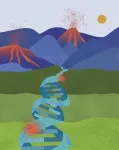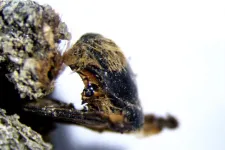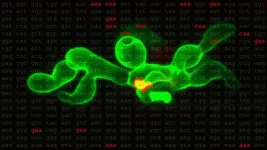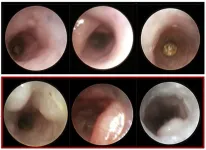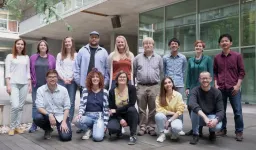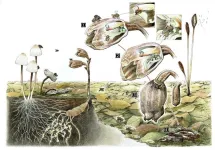(Press-News.org) Researchers at the University of California San Diego have uncovered a connection between the topography of the human genome and the presence of mutations in human cancer. They found that certain regions of the genome, which exhibit unique features, act as hotspots for the accumulation of mutations.
The findings, published recently in Cell Reports, shed light on how the 3D architecture of the human genome may play a role in the development of various forms of cancer.
The human genome is often visualized as the iconic DNA double helix, composed of long sequences of the letters A, C, G and T. “However, the genome is far more than that,” explained study senior author Ludmil Alexandrov, professor of bioengineering and cellular and molecular medicine at UC San Diego. “Like Earth with its diverse landscapes, the genome has a rich topography made up of different structures, shapes and features.”
For example, the genome contains sections where DNA tightly coils, as well as sections where it coils more loosely. Some sections are looped. The genome also possesses various features, such as one called replication timing, where certain regions of the genome are copied early during cell division, while other regions are copied much later.
Alexandrov’s team performed a comprehensive study of how this genomic topography influences where mutations in cancer arise across the human genome. Just as different terrains on Earth foster distinct ecosystems, certain topographic features in the genome seem to provide an environment for specific mutations to thrive.
“When studying the genome of a cancer, we usually assume that mutations accumulate randomly across that genome. However, this is not the case as different parts of the genome have different features,” said Alexandrov.
“With our topographic analysis, we show that certain mutations in cancer preferentially accumulate in certain regions of the genome,” said study first author Burçak Otlu, a former postdoctoral researcher in Alexandrov’s lab.
The researchers examined all the known genome topographical features and looked for connections with specific patterns of mutations, known as mutational signatures, across all human cancers. In total, they analyzed the effects of 516 topographical features on mutational signatures across 5,120 whole-genome sequenced tumors from 40 cancer types.
One of this study’s key findings is that several mutational signatures linked to alcohol consumption accumulate in regions of the genome that are copied early during cell division. This connection was specifically seen in three types of cancers: esophageal, head and neck, and liver.
This finding is unexpected, the researchers noted, because mutations tend to arise in regions that are copied in the later stages of cell division, as this is where errors occur more frequently. DNA replication during early cell division is more precise, affording early-replicated genome segments greater protection from mutations. However, the researchers found that the opposite is happening when it comes to alcohol consumption-related mutational signatures.
The researchers also observed something interesting with mutational signatures tied to the antiviral activity of a set of enzymes known as APOBEC3 deaminases. They found that these mutational signatures accumulate in both early- and late-replicated regions of the genome.
“These findings are significant because a lot of essential genes live in the early-replicated regions of the genome,” said Alexandrov. “Our research shows that certain mutagenic processes are not playing by the regular rules, so they could potentially be hitting key genes and pathways that are normally protected.”
The team compiled the findings of this study in the form of an online resource. Researchers can use it to look up which topographical features are linked to which mutational signatures, and vice versa. It also shows which cancer types exhibit these connections.
“Such a resource will be invaluable for future studies focused on understanding the role of topographical features in cancer development, evolution and treatment,” said Otlu.
Paper title: “Topography of mutational signatures in human cancer.” Co-authors include Burçak Otlu (now an assistant professor at Middle East Technical University, Turkey), Marcos Diaz-Gay, Erik N. Bergstrom, Maria Zhivagui, Mark Barnes and Ludmil B. Alexandrov, UC San Diego; and Ian Vermes, Wellcome Sanger Institute, UK.
This work is supported in part by a Cancer Research UK Grand Challenge Award (C98/A24032) and the National Institutes of Health (R01ES030993, R01ES032547 and R01CA269919).
Disclosures: Ludmil Alexandrov is a compensated consultant and has equity interest in io9, LLC and Genome Insight. His spouse is an employee of Biotheranostics, Inc. He is also an inventor of U.S. Patent 10,776,718 for source identification by non-negative matrix factorization and declares U.S. provisional applications with serial numbers: 63/366,392, 63/412,835 and 63/492,348. Alexandrov and Erik Bergstrom declare U.S. provisional applications with serial numbers 63/289,601, 63/269,033 and 63/438,237.
END
Topography of the genome influences where cancer mutations thrive, study shows
2023-08-24
ELSE PRESS RELEASES FROM THIS DATE:
Pioneering treatment highly effective for rare kidney disease
2023-08-24
A pioneering drug for a rare kidney disease prevents organ failure and significantly improves the outcome for patients, new research has confirmed.
Atypical Haemolytic Uraemic Syndrome (aHUS) is a genetic life-threatening condition caused by a defect in the immune system which leads to kidney failure.
Newcastle University, UK, carried out clinical trials into the drug, eculizumab, which eventually led to the NHS approving the treatment for use in patients from 2015.
Now, a study by Newcastle experts, published in Blood, ...
Getting protein factories to run – How deubiquitinating enzymes moonlight as Fubi proteases
2023-08-24
Fubi is produced by cells as a fusion protein with the ribosomal protein S30, and must be separated from S30 by proteases for functioning ribosomes. In immune cells, this by-product of ribosome production is utilized as a secreted signalling molecule, for example to locally reduce the activity of the maternal immune system in the uterus and to thus enable embryos to implant. How Fubi is specifically recognized by proteases and how they distinguish it from ubiquitin was previously unknown.
First author Rachel O’Dea and Malte Gersch explain their research in detail:
What is the discovery that you made and why is it exciting?
Our team revealed ...
Eureka win for researchers behind new anti-cancer strategy
2023-08-24
Associate Professor Tim Thomas and Professor Anne Voss from WEHI (Melbourne, Australia) have been awarded the 2023 UNSW Eureka Prize for Scientific Research.
The prize recognises their groundbreaking research in developing a new class of drugs that can put cancer cells ‘to sleep’ without triggering the harmful side effects caused by conventional cancer treatments, like chemotherapy and radiation.
The Australian Museum Eureka Prizes are among Australia’s most distinguished science awards, honouring excellence across the areas of research and innovation, leadership, science engagement, and school science.
At a glance
Associate Professor Tim Thomas and Professor ...
Cattle farming expansion and unchecked climate change would expose more than 1 billion cows to heat stress
2023-08-24
More than 1 billion cows around the world will experience heat stress by the end of the century if carbon emissions are high and environmental protection is low, according to new research published today in IOP Publishing’s journal Environmental Research Letters.
This would mean cattle farming would face potentially lethal heat stress in much of the world, including Central America, tropical South America, Equatorial Africa, and South and Southeast Asia. The research also found that rapidly reducing greenhouse gas emissions, as well as keeping cattle production close to current levels, would reduce these impacts by at least 50% in Asia, 63% in South America, and ...
Bees from the time of the pharaohs found mummified on the Southwest Coast of Portugal
2023-08-24
A new study reports the discovery of hundreds of mummified bees inside their cocoons. These cocoons, produced almost three thousand years ago, were discovered in a new paleontological site discovered on the coast of Odemira, in Portugal.
About 2975 years ago, Pharaoh Siamun reigned in Lower Egypt; in China the Zhou Dynasty elapsed; Solomon was to succeed David on the throne of Israel; in the territory that is now Portugal, the tribes were heading towards the end of the Bronze Age. In particular, on the southwest coast of Portugal, where is now Odemira, something strange and rare ...
Study IDs secret of stealthy invader essential to ruinous rice disease
2023-08-24
The virulence of a rice-wrecking fungus — and deployment of ninja-like proteins that help it escape detection by muffling an immune system’s alarm bells — relies on genetic decoding quirks that could prove central to stopping it, says research from the University of Nebraska–Lincoln.
A Nebraska team helmed by Richard Wilson hopes that identifying an essential but formerly unknown stage in the fungal takeover of rice cells can accelerate the treatment or prevention of rice blast disease, which ruins up to 30% of global yields each year.
“The response I’ve gotten from people in my field is that they’re very excited, ...
Mutations in blood stem cells can exacerbate colon cancer
2023-08-24
Researchers at the University of Florida College of Medicine have discovered how common age-related changes in the blood system can make certain colon cancers grow faster. The study, to be published August 24 in the Journal of Experimental Medicine (JEM), also suggests how these effects might be therapeutically targeted to reduce tumor growth and improve patient survival.
As we age, the hematopoietic stem cells that reside in the bone marrow and give rise to all of the body’s different blood cells gradually acquire mutations in their ...
The ‘treadmill conveyor belt’ ensuring proper cell division
2023-08-24
Researchers at the Centre for Genomic Regulation (CRG) have discovered how proteins work in tandem to regulate ‘treadmilling’, a mechanism used by the network of microtubules inside cells to ensure proper cell division. The findings are published today in the Journal of Cell Biology.
Microtubules are long tubes made of proteins that serve as infrastructure to connect different regions inside of a cell. Microtubules are also critical for cell division, where they are key components of the spindle, the structure which attaches itself to chromosomes and pulls them apart into each new cell.
For the spindle to function properly, cells rely on microtubules to ‘treadmill’. ...
Significant progress in cell separation technology made by Griffith University team
2023-08-24
Early detection allows for timely intervention in many diseases before they progress to a severe stage, often at a lower treatment cost. This is particularly crucial in the case of cancer, as the stage of cancer development at the time of initial diagnosis significantly influences the patient's prognosis and survival rate. Therefore, regular medical check-ups can ensure better survival and quality of life. However, the multitude of medical examination items makes the experience both loved and loathed. With various ...
Fungi-eating plants and flies team up for reproduction
2023-08-24
Fungi-eating orchids were found for the first time to offer their flowers to fungi-eating fruit flies in exchange for pollination, which is the first evidence for nursery pollination in orchids. This unique new plant-animal relationship hints at an evolutionary transition towards mutualistic symbiosis.
Orchids are well known to trick their pollinators into visiting the flowers by imitating food sources, breeding grounds or even mates without actually offering anything in return. The fungi-eating, non-photosynthetic orchid genus Gastrodia is no different: To attract fruit flies (Drosophila spp.), the plants usually emits a smell like their common diet of fermented fruits ...
